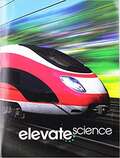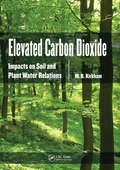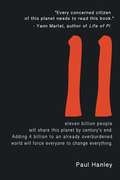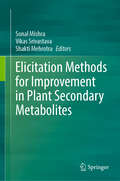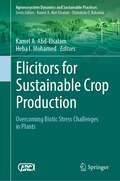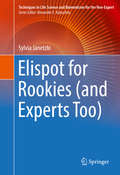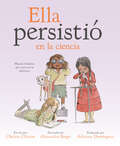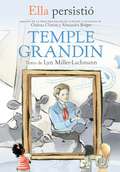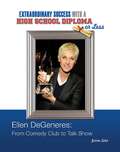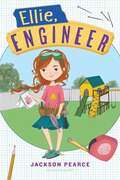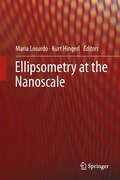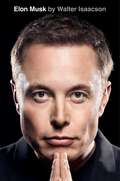- Table View
- List View
Elevate Science: Grade 4
by PearsonElevate Science is a comprehensive K-5 science program that focuses on active, student-centered learning. Elevate Science builds students' critical thinking, questioning, and collaboration skills. It fuels interest in STEM and creative problem solving while supporting literacy development for elementary-age learners.
Elevated Carbon Dioxide: Impacts on Soil and Plant Water Relations
by M.B. KirkhamBetween 1958 and 2008, the CO2 concentration in the atmosphere increased from 316 to 385 ppm. Continued increases in CO2 concentration will significantly affect long-term climate change, including variations in agricultural yields. Focusing on this critical issue, Elevated Carbon Dioxide: Impacts on Soil and Plant Water Relations presents research
Eleven
by Paul HanleyThe sweeping changes that make a 'full world' work-involving dual processes of destruction and reconstruction-will transform global culture, agriculture, and ultimately the human race. ELEVEN is a call to consciousness. Only an 'ethical revolution' will allow us to carry forward an ever-advancing civilization.
Elicitation Methods for Improvement in Plant Secondary Metabolites
by Vikas Srivastava Shakti Mehrotra Sonal MishraThe book explores theoretical as well as rational information associated with elicitation as a biotechnological strategy and a potential method to produce and/or enhance the production of high value-low volume compounds in plants and other organisms. Further, the book is intended to provide a comprehensive insight into elicitation, diverse elicitors and their mechanism of action, applications, and future prospects and covers diverse phenomenon and selected case studies that a subject reader needs to know. Furthermore, an attempt has also been made to identify challenges in existing methodologies of elicitation and their feasible solutions through scientific discussions in various chapters provided by eminent research groups. This book aids academicians, researchers and plant metabolite-based industry persons to understand the elicitor-mediated metabolic regulation in detail. It is also a reference for the students studying plant biochemical pathways and their regulation in response to environmental constraints.
Elicitors for Sustainable Crop Production: Overcoming Biotic Stress Challenges in Plants (Sustainability Sciences in Asia and Africa)
by Kamel A. Abd-Elsalam Heba I. MohamedThis book covers all aspects of biotic stress, with detailed focus on elicitors to alleviate adverse effects on plant development and growth. Elicitors are substances that can trigger plants to mount defenses against biotic stressors. Exogenous elicitor application prior to stress events modifies transcription factors, enhancing plant resilience. This book explores the role and applications of elicitors that activate a plant's immune system, leading to increased resistance against biotic stressors. This book also explains how elicitors, both abiotic and biotic, can trigger physiological and morphological responses and phytoalexin accumulation. By reducing reliance on harmful pesticides, this guide fosters a more sustainable and environmentally friendly agricultural approach. " This book is a resource for researchers, agricultural professionals, and farmers seeking solutions to combat biotic stress in crops. Whether you're a seasoned grower or just starting out, this book provides practical strategies and insights to safeguard your crops and achieve a healthier, more productive harvest, empowering you to cultivate a thriving future for your crops and the environment.
Elispot for Rookies (and Experts Too)
by Sylvia JanetzkiThis book provides basic, simple, and logical explanations for choices to be made to run the best Elispot possible. It allows the newcomer to truly understand the best options for specific protocol steps, reagents and materials, and provides even the experienced Elispot user with insight into best practices. The techniques presented here are supported by the author's twenty-plus years of first-hand experience working with this assay, as well as the shared experiences of numerous colleagues and collaborators. The enzyme-linked immunospot (Elispot) assay is a widely used technique to monitor cells on the single cell level for the release of analytes like cytokines, chemokines or immunoglobulins (antibodies), in response to particular stimuli. The most important feature of Elispot is its outstanding sensitivity, allowing the detection of specific cells in very low frequencies. The advantages of Elispot have resulted in it being widely adapted for use in research and translational applications in numerous fields including cancer, infectious diseases, autoimmunity, and transplantation.
Elixir
by James O. SyElixir is a thrilling, highly entertaining science fiction novel. It is the first installment of a six-part sci-fi series. Book 1 slowly unfolds the events that lead a college sophomore to discover the powers he possesses, powers that are not of this Earth. This first installment is replete with religious themes and teachings. It also narrates the protagonist’s first encounter with an extraterrestrial being, and how he stumbles upon a miracle cure—an elixir. <P><P>The protagonist’s father and missionary grandparents are used by the author to express his personal religious beliefs and convictions.This first installment of the Elixir series revealed the extreme potency and efficacy of the all-curing magical elixir when used by the mortally wounded extra-terrestrial. But there are very important differences when this alien-manufactured medicine is used by humans. Even the alien scientists working on this miracle drug were amazed and impressed by their findings. They found out about the incredible effects when it was used on some of their human guinea pigs. Much of Book Two of the six-part series will focus on the stupefying results of this wonder drug on humans—and all the good and bad things that might result as a consequence of the relative availability of the elixir. The magical elixir became a much in-demand, much sought-after, ultra-precious and valuable wonder drug. <P> Not wanting to waste a grand opportunity to use these vials of magical elixir to benefit a swath of humanity, Jerry and his young son JT came out with this bold and brilliant move: they would auction off, to the highest bidders, a couple vials of miracle elixir. The brilliance of the plan is in the singularity of its purpose. Its sole purpose is to use the fund generated from the auction to benefit a wide swath of humanity. This is just a prototype, a scaled-down version of a grand vision. Because of the limitations presented by the availability of just a few vials of the miracle drug, a much grander and more magnificent version of the plan would have to wait. Book Two will solve the limited-availability problem of the magical elixir and will unfold the execution of the gloriously magnificent blueprint that the Almighty has planned to serve the poverty-stricken, hopeless, forsaken, and shunned segment of society.
Elixir: A Parisian Perfume House and the Quest for the Secret of Life
by Theresa LevittA story of alchemy in Bohemian Paris, where two scientific outcasts discovered a fundamental distinction between natural and synthetic chemicals that inaugurated an enduring scientific mystery.For centuries, scientists believed that living matter possessed a special quality—a spirit or essence—that differentiated it from nonliving matter. But by the nineteenth century, the scientific consensus was that the building blocks of one were identical to the building blocks of the other. Elixir tells the story of two young chemists who were not convinced, and how their work rewrote the boundary between life and nonlife.In the 1830s, Édouard Laugier and Auguste Laurent were working in Laugier Père et Fils, the oldest perfume house in Paris. By day they prepared the perfumery’s revitalizing elixirs and rejuvenating eaux, drawing on alchemical traditions that equated a plant’s vitality with its aroma. In their spare time they hunted the vital force that promised to reveal the secret to life itself. Their ideas, roundly condemned by established chemists, led to the discovery of structural differences between naturally occurring molecules and their synthetic counterparts, even when the molecules were chemically identical.Scientists still can’t explain this anomaly, but it may point to critical insights concerning the origins of life on Earth. Rich in sparks and smells, brimming with eccentric characters, experimental daring, and the romance of the Bohemian salon, Elixir is a fascinating cultural and scientific history.
Elixir: A Story of Perfume, Science and the Search for the Secret of Life
by Theresa Levitt'Dizzying and fragrant . . . truly a captivating achievement!' Aimee Nezhukumatathil'If you read this book you will be changed . . . this book feels like an actual elixir' Kiese Laymon'A fascinating tale of discovery, wonder, and revolution' Matthew StanleyTwo friends in a Parisian perfume shop make a discovery that will transform our understanding of the world and the origins of life on Earth forever.Set amidst the unforgettable sights and smells of 18th and 19th Century Paris, Elixir tells the story of Edouard Laugier and Auguste Laurent, the son of a perfumer and a fellow aspiring chemist, who met on the Left Bank while pursuing their passion for science. Spurned by the scientific establishment, the pair ended up working out of Edouard's family perfume shop, Laugier père et fils. By day they prepared the revitalizing elixirs and rejuvenating eaux it was famous for, but by night using the ingredients of the perfumery and the principles of alchemy, they pursued the secret of life itself.Elixir reads like a novel, brimming with eccentric characters, experimental daring, and the romance of the Bohemian salon. It is the story of a long-standing scientific puzzle and the struggle to gain acceptance for a new way of thinking about the building blocks of living matter long after those who discovered it were both dead. Yet this is also a story of hope and determination. For while the scientific establishment ridiculed their work at the time, teenage lab assistant Louis Pasteur took it seriously and over the course of an exceptional career, was able to show that their work pointed to a deep, inexplicable asymmetry in the molecular arrangement of living things - an unexplained asymmetry which remains one of science's great mysteries.
Elixir: A Story of Perfume, Science and the Search for the Secret of Life
by Theresa LevittTwo friends in a Parisian perfume shop make a discovery that will transform our understanding of the world and the origins of life on Earth forever.Set amidst the unforgettable sights and smells of 18th and 19th Century Paris, Elixir tells the story of Edouard Laugier and Auguste Laurent, the son of a perfumer and a fellow aspiring chemist, who met on the Left Bank while pursuing their passion for science. Spurned by the scientific establishment, the pair ended up working out of Edouard's family perfume shop, Laugier père et fils. By day they prepared the revitalizing elixirs and rejuvenating eaux it was famous for, but by night using the ingredients of the perfumery and the principles of alchemy, they pursued the secret of life itself. Elixir reads like a novel, brimming with eccentric characters, experimental daring, and the romance of the Bohemian salon. It is the story of a long-standing scientific puzzle and the struggle to gain acceptance for a new way of thinking about the building blocks of living matter long after those who discovered it were both dead. Yet this is also a story of hope and determination. For while the scientific establishment ridiculed their work at the time, teenage lab assistant Louis Pasteur took it seriously and over the course of an exceptional career, was able to show that their work pointed to a deep, inexplicable asymmetry in the molecular arrangement of living things - an unexplained asymmetry which remains one of science's great mysteries.'Dizzying and fragrant, elegant and riveting . . . truly a captivating achievement!' Aimee Nezhukumatathil'If you read this book you will be changed . . . this book feels like an actual elixir. Absolutely stunning' Kiese Laymon(P) 2023 Hodder & Stoughton Limited
Eliza and the Sacred Mountain
by Virginia BernardWhile spending the summer on an archaeological dig in Oaxaca, Mexico, with Uncle Carl and his girlfriend, Eliza Lomax meets a Zapotec boy who takes her back in time to try to stop a deadly game meant to punish her uncle for disturbing the dead.
Elizabeth Blackburn and the Story of Telomeres: Deciphering the Ends of DNA (The\mit Press Ser.)
by Catherine BradyThe story of molecular biologist Elizabeth Blackburn and her groundbreaking research on telomeres and what it reveals about the resourceful opportunism that characterizes the best scientific thinking.Molecular biologist Elizabeth Blackburn—one of Time magazine's 100 “Most Influential People in the World” in 2007—made headlines in 2004 when she was dismissed from the President's Council on Bioethics after objecting to the council's call for a moratorium on stem cell research and protesting the suppression of relevant scientific evidence in its final report. But it is Blackburn's groundbreaking work on telomeric DNA, which launched the field of telomere research, that will have the more profound and long-lasting effect on science and society. In this compelling biography, Catherine Brady tells the story of Elizabeth Blackburn's life and work and the emergence of a new field of scientific research on the specialized ends of chromosomes and the enzyme, telomerase, that extends them. In the early stages of telomere research, telomerase, heralded as a potential cure for cancer and diseases related to aging, attracted the voracious interest of biotech companies. The surrounding hype succeeded in confusing the role of telemorase in extending the life of a cell with a mechanism that might extend the lifespan of an entire organism. In Brady's hands, Blackburn's story reveals much about the tension between pure and applied science, the politicking that makes research science such a competitive field, and the resourceful opportunism that characterizes the best scientific thinking.Brady describes the science accessibly and compellingly. She explores Blackburn's struggle to break down barriers in an elite, male-dominated profession, her role as a mentor to other women scientists (many of whom have made their mark in telomere research), and the collaborative nature of scientific work. This book gives us a vivid portrait of an exceptional woman and a new understanding of the combination of curiosity, imaginative speculation, and aesthetic delight that powers scientific discovery.
Elizabeth, Queen of the Seas
by Lynne Cox Brian FlocaWorld-renowned swimmer and bestselling author Lynne Cox and Caldecott Medal-winning illustrator Brian Floca team up to bring us this inspiring story of an elephant seal who knew exactly where she belonged. Here is the incredible story of Elizabeth, a real-life elephant seal who made her home in the Avon River in the city of Christchurch, New Zealand. When Elizabeth decides to stretch out across a two-lane road, the citizens worry she might get hurt or cause traffic accidents, so a group of volunteers tows her out to sea. But Elizabeth swims all the way back to Christchurch. The volunteers catch her again and again--each time towing her farther, even hundreds of miles away--but, still, Elizabeth finds her way back home. Includes back matter with information about elephant seals.From the Hardcover edition.
Ella persistió en la ciencia: Mujeres brillantes que marcaron la diferencia (She Persisted)
by Chelsea ClintonA STEM-focused addition to the #1 New York Times bestselling She Persisted series! Now available in Spanish!A lo largo de la historia, a las mujeres les han dicho que la ciencia no es para ellas porque no son suficientemente inteligentes, o porque sus cerebros simplemente no son capaces de ese tipo de estudio. En este libro, Chelsea Clinton nos presenta a varias mujeres científicas que no prestaron atención a los que les dijeron que no y optaron por utilizar su ingenio, sus habilidades y su persistencia para descubrir, inventar, crear y explicar. Ella persistió en la ciencia es un libro para todos aquéllos que se han hecho preguntas sobre el mundo que los rodea o sobre cómo funcionan las cosas, y que se niegan a darse por vencidos hasta hallar las respuestas. Las expresivas ilustraciones de Alexandra Boiger que acompañan este inspirador texto muestran a los lectores que todos tenemos el potencial de marcar la diferencia y que las mujeres científicas cambian el mundo.
Ella persistió: Temple Grandin / She Persisted: Temple Grandin
by Lyn Miller-Lachmann Chelsea ClintonInspirado en el bestseller #1 del New York Times Ella persistió de Chelsea Clinton y Alexandra Boiger, llega ahora esta serie en Chapter Books sobre mujeres que sobresalieron, lucharon y se levantaron contra viento y marea. Cuando las vacas, los caballos y otros animales sufrían, Temple Grandin parecía entenderlos mejor que nadie. Temple es autista, y esto determinó que pensara de una manera diferente al resto de las personas; no inferior, solo diferente. Cuando llegó a la edad adulta, se esforzó por explicar cómo el hecho de ser autista influyó en su trabajo y en su vida, ayudando a las personas sin autismo a comprender mejor a las que lo tenían. Temple se convirtió en una científica de renombre mundial, experta en comportamiento animal, y ha utilizado su forma de ver el mundo para inventar y lograr grandes cosas, siempre ayudando a otros en el camino. En este libro biográfico de la galardonada autora Lyn Miller-Lachmann, los lectores aprenden sobre la asombrosa vida de Temple Grandin y cómo persistió. ¡El libro se completa con una introducción de Chelsea Clinton!
Ellen Ochoa (Hispanic Star)
by Claudia Romo Edelman Nathalie AlonsoRead about the first Latina in space, Ellen Ochoa, one of the most groundbreaking, iconic Hispanic and Latinx heroes that have shaped our culture and the world, in this gripping biography written by Claudia Romo Edelman and Nathalie Alonso, with black-and-white illustrations by Manuel Gutierrez, perfect for fans of the Who Was and She Persisted series. <p><p> Meet award-winning engineer and veteran astronaut Ellen Ochoa—once just a girl from Los Angeles, California. The granddaughter of Mexican immigrants, Ellen would pursue a career in physics at a young age and go on to earn master’s and doctorate degrees in electrical engineering from Stanford University. In 1993, Ellen became the first Latina in space. As a retired astronaut, she became the first Hispanic and second female director of the Johnson Space Center, has been an advocate for women and minorities in STEM fields, and was inducted into the Astronaut Hall of Fame.
Ellen Ochoa: Astronaut and Inventor
by Anne SchraffExplores the life of Ellen Ochoa from her childhood in California to her missions in space. On April 6, 1993, Ellen Ochoa, a mission specialist, sat in the space shuttle DISCOVERY, waiting for liftoff. As the launch pad rumbled and the engines ignited, the DISCOVERY exploded upward into the sky. With this space shuttle launch, Ellen Ochoa became the first Latina to enter space. A brilliant inventor and an experienced astronaut, Ochoa quickly moved up the ranks at NASA and toured schools throughout the country, encouraging students to follow their dreams.
Ellen DeGeneres: From Comedy Club to Talk Show (Extraordinary Success with a High School)
by Jaime SebaIn the last few decades, more and more people are going to college to further their education. It's hard to become a scientist, a professor, or a businessperson without getting some sort of college degree--but college isn't always necessary to achieve success. Some people are ready to enter the workforce right after high school. Ellen DeGeneres was one of those people. The comedian began her career doing stand-up routines in New Orleans coffee houses. Today, Ellen has one of the most successful talk shows on television and stars in commercials for everything from credit cards to makeup. She's even judged "American Idol"! And what's most amazing about her story is that the charming talk show host has done it all without a college degree!
Ellie, Engineer
by Jackson PearceA charming, hilarious illustrated middle grade about a girl who is an engineer--no, not the kind on a train, the kind that builds things! Perfect creative, STEM-powered fun for girls who have interests in how things work. Ellie is an engineer. With a tool belt strapped over her favorite skirt (who says you can’t wear a dress and have two kinds of screwdrivers handy, just in case?), she invents and builds amazing creations in her backyard workshop. Together with her best friend Kit, Ellie can make anything. As Kit’s birthday nears, Ellie doesn’t know what gift to make until the girls overhear Kit’s mom talking about her present--the dog Kit always wanted! Ellie plans to make an amazing doghouse, but her plans grow so elaborate that she has to enlist help from the neighbor boys and crafty girls, even though the two groups don’t get along. Will Ellie be able to pull off her biggest project yet, all while keeping a secret from Kit? Illustrated with Ellie’s sketches and plans, and including backmatter with a fun how-to guide to tools, this is a STEM- and friendship-powered story full of fun!
Ellipsometry at the Nanoscale
by Kurt Hingerl Maria LosurdoThis book presents and introduces ellipsometry in nanoscience and nanotechnology making a bridge between the classical and nanoscale optical behaviour of materials. It delineates the role of the non-destructive and non-invasive optical diagnostics of ellipsometry in improving science and technology of nanomaterials and related processes by illustrating its exploitation, ranging from fundamental studies of the physics and chemistry of nanostructures to the ultimate goal of turnkey manufacturing control. This book is written for a broad readership: materials scientists, researchers, engineers, as well as students and nanotechnology operators who want to deepen their knowledge about both basics and applications of ellipsometry to nanoscale phenomena. It starts as a general introduction for people curious to enter the fields of ellipsometry and polarimetry applied to nanomaterials and progresses to articles by experts on specific fields that span from plasmonics, optics, to semiconductors and flexible electronics. The core belief reflected in this book is that ellipsometry applied at the nanoscale offers new ways of addressing many current needs. The book also explores forward-looking potential applications.
Elliptic Extensions in Statistical and Stochastic Systems (SpringerBriefs in Mathematical Physics #47)
by Makoto KatoriHermite's theorem makes it known that there are three levels of mathematical frames in which a simple addition formula is valid. They are rational, q-analogue, and elliptic-analogue. Based on the addition formula and associated mathematical structures, productive studies have been carried out in the process of q-extension of the rational (classical) formulas in enumerative combinatorics, theory of special functions, representation theory, study of integrable systems, and so on. Originating from the paper by Date, Jimbo, Kuniba, Miwa, and Okado on the exactly solvable statistical mechanics models using the theta function identities (1987), the formulas obtained at the q-level are now extended to the elliptic level in many research fields in mathematics and theoretical physics. In the present monograph, the recent progress of the elliptic extensions in the study of statistical and stochastic models in equilibrium and nonequilibrium statistical mechanics and probability theory is shown. At the elliptic level, many special functions are used, including Jacobi's theta functions, Weierstrass elliptic functions, Jacobi's elliptic functions, and others. This monograph is not intended to be a handbook of mathematical formulas of these elliptic functions, however. Thus, use is made only of the theta function of a complex-valued argument and a real-valued nome, which is a simplified version of the four kinds of Jacobi's theta functions. Then, the seven systems of orthogonal theta functions, written using a polynomial of the argument multiplied by a single theta function, or pairs of such functions, can be defined. They were introduced by Rosengren and Schlosser (2006), in association with the seven irreducible reduced affine root systems. Using Rosengren and Schlosser's theta functions, non-colliding Brownian bridges on a one-dimensional torus and an interval are discussed, along with determinantal point processes on a two-dimensional torus. Their scaling limits are argued, and the infinite particle systems are derived. Such limit transitions will be regarded as the mathematical realizations of the thermodynamic or hydrodynamic limits that are central subjects of statistical mechanics.
Elmwood Park Zoo (Images of Modern America)
by Jerry Spinelli Stan HuskeyElmwood Park Zoo was established in 1924 when roughly 16 acres of land and a small group of animals were donated to the borough of Norristown. Although the early years of the zoo were more akin to a small farm, it has gone through an extensive expansion during the past few decades. This expansion and the continued revitalization of Elmwood Park Zoo include some notable residents, such as the zoo's owl, who has become the mascot of Temple University, and its bald eagle, a sideline regular for the NFL's Philadelphia Eagles. The zoo today, with new features including a zip line and a giraffe exhibit, looks to the future, with plans for even more exhibits, a new restaurant, and an additional 20 acres yet to be developed.
Elon Musk
by Walter IsaacsonDo autor de Steve Jobs e outras biografias de sucesso, chega-nos a história surpreendentemente íntima de um dos inovadores mais controversos e fascinantes da atualidade - um visionário avesso a regras que levou o mundo para a era dos carros elétricos, da exploração espacial de iniciativa privada e da inteligência artificial. Ah, e comprou o Twitter. Entrega a partir de 12 de Setembro de 2023.Durante a sua infância, na África do Sul, Elon Musk foi vítima de bullying. Um dia, foi empurrado de umas escadas de cimento abaixo e pontapeado no rosto até este ficar uma massa ensanguentada e inchada. Ficou internado durante uma semana. Mas as mazelas físicas eram insignificantes quando comparadas com as feridas emocionais infligidas pelo seu pai, um carismático e engenhoso fantasista que agia por conta própria. Quando Elon teve alta do hospital, o pai repreendeu-o. «Tive de ficar de pé uma hora a ouvi-lo gritar comigo, a chamar-me idiota e a dizer-me que era um inútil», recorda. O impacto do pai na sua psique permaneceria. Transformou-se num homem-criança duro, apesar de vulnerável, com uma tolerância extraordinariamente alta ao risco, sedento de drama e com um sentido épico de missão e uma obstinação maníaca, tão insensível quanto, por vezes, destrutiva. No início de 2022 ? depois de um ano marcado pelo lançamento e colocação em órbita de 31 foguetes da SpaceX, pela marca de um milhão de carros vendidos pela Tesla e de se tornar o homem mais rico do mundo ?, Musk falou com pesar sobre a sua compulsão para criar dramas. «Preciso de mudar de mentalidade, sair do modo de crise, que é como tenho funcionado nos últimos catorze anos, pelo menos, se não a maior parte da minha vida», disse. Foi um comentário melancólico, não uma resolução de Ano Novo. Ao mesmo tempo que se comprometia a mudar, comprava, em segredo, ações do Twitter, o maior recreio do mundo. Ao longo dos anos, sempre que se encontrava num lugar mais sombrio, voltava a ser aquela criança agredida no recreio. Agora, tinha a oportunidade de ser o dono do recreio. CRÍTICAS A STEVE JOBS, DE WALTER ISAACSON "Fascinante." - The New York Times "Hipnotizante" - LA Times "Vibrante." - Kirkus Reviews "Um retrato vasto e complexo - mas incrivelmente consistente - do homem que criou a Apple." - The Verge "Uma narrativa franca e cativante" - Publishers Weekly
Elon Musk
by Walter IsaacsonFrom the author of Steve Jobs and other bestselling biographies, this is the astonishingly intimate story of the most fascinating and controversial innovator of our era—a rule-breaking visionary who helped to lead the world into the era of electric vehicles, private space exploration, and artificial intelligence. Oh, and took over Twitter.Australian Financial Review Top 20 Read for 2023 When Elon Musk was a kid in South Africa, he was regularly beaten by bullies. One day a group pushed him down some concrete steps and kicked him until his face was a swollen ball of flesh. He was in the hospital for a week. But the physical scars were minor compared to the emotional ones inflicted by his father, an engineer, rogue, and charismatic fantasist. His father&’s impact on his psyche would linger. He developed into a tough yet vulnerable man-child, prone to abrupt Jekyll-and-Hyde mood swings, with an exceedingly high tolerance for risk, a craving for drama, an epic sense of mission, and a maniacal intensity that was callous and at times destructive. At the beginning of 2022—after a year marked by SpaceX launching thirty-one rockets into orbit, Tesla selling a million cars, and him becoming the richest man on earth—Musk spoke ruefully about his compulsion to stir up dramas. &“I need to shift my mindset away from being in crisis mode, which it has been for about fourteen years now, or arguably most of my life,&” he said. It was a wistful comment, not a New Year&’s resolution. Even as he said it, he was secretly buying up shares of Twitter, the world&’s ultimate playground. Over the years, whenever he was in a dark place, his mind went back to being bullied on the playground. Now he had the chance to own the playground. For two years, Isaacson shadowed Musk, attended his meetings, walked his factories with him, and spent hours interviewing him, his family, friends, coworkers, and adversaries. The result is the revealing inside story, filled with amazing tales of triumphs and turmoil, that addresses the question: are the demons that drive Musk also what it takes to drive innovation and progress?
